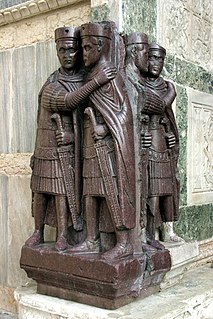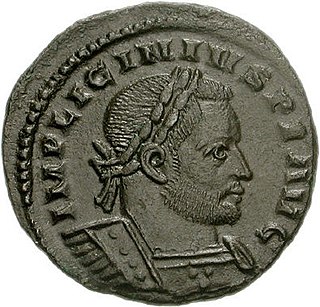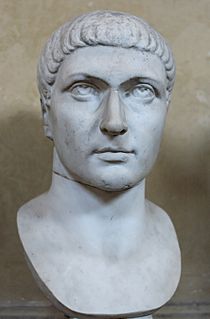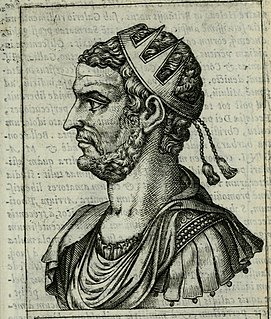Sources
| | This biographical article related to the military is a stub. You can help Wikipedia by expanding it. |
Alica was a Thervingian Gothic warrior. He was an ally of Licinius against Constantine the Great, who in 323 had invaded Gothic territory and killed the warrior Rausimod. Alica supported Licinius in his battles with Constantine in 324. After Licinius had been defeated and deposed by Constantine, he tried to regain power with Gothic help, but his plans were exposed and he was sentenced to death. Licinius then tried to escape into Gothic territory, but was apprehended at Thessaloniki and executed.
| | This biographical article related to the military is a stub. You can help Wikipedia by expanding it. |

Flavius Julius Constans was Roman emperor from 337 to 350. He held the imperial rank of caesar from 333, and was the youngest son of Constantine the Great.

Constantine I, also known as Constantine the Great, was a Roman emperor from 306 to 337. Born in Naissus, Dacia Mediterranea, he was the son of Flavius Constantius, an Illyrian army officer who became one of the four emperors of the Tetrarchy. His mother, Helena, was Greek and of low birth. Constantine served with distinction under emperors Diocletian and Galerius campaigning in the eastern provinces against barbarians and the Persians, before being recalled west in 305 to fight under his father in Britain. After his father's death in 306, Constantine was acclaimed as emperor by the army at Eboracum (York). He emerged victorious in the civil wars against emperors Maxentius and Licinius to become sole ruler of the Roman Empire by 324.

The Tetrarchy is the term adopted to describe the system of government of the ancient Roman Empire instituted by Roman Emperor Diocletian in 293, marking the end of the Crisis of the Third Century and the recovery of the Roman Empire. The government of the empire was divided between the two senior emperors, the augusti, and their juniors and designated successors, the caesares.
The 310s decade ran from January 1, 310, to December 31, 319.

Licinius was Roman emperor from 308 to 324. For most of his reign he was the colleague and rival of Constantine I, with whom he co-authored the Edict of Milan, AD 313, that granted official toleration to Christians in the Roman Empire. He was finally defeated at the Battle of Chrysopolis, and was later executed on the orders of Constantine I.

Maxentius was Roman emperor from 306 to 312. He was the son of former Emperor Maximian and the son-in-law of Emperor Galerius. The latter part of his reign was preoccupied with civil war, allying with Maximinus II against Licinius and Constantine. The latter defeated him at the Battle of the Milvian Bridge in 312, where Maxentius, with his army in flight, purportedly perished by drowning in the Tiber river.

Flavius Julius Crispus was the eldest son of the Roman emperor Constantine the Great and his junior emperor (caesar) from March 317 until his execution by his father in 326. The grandson of the augustus Constantius I, Crispus was the elder half-brother of the future augustus Constantine II and became co-caesar with him and with his cousin Licinius II at Serdica, part of the settlement ending the Cibalensean War between Constantine and his father's rival Licinius I. Crispus ruled from Augusta Treverorum (Trier) in Roman Gaul between 318 and 323 and defeated the navy of Licinius I at the Battle of the Hellespont in 324, which with the land Battle of Chrysopolis won by Constantine forced the resignation of Licinius and his son, leaving Constantine the sole augustus and the Constantinian dynasty in control of the entire empire. It is unclear what was legal status of the relationship Crispus's mother Minervina had with Constantine; Crispus may have been an illegitimate son.

The Edict of Milan was the February AD 313 agreement to treat Christians benevolently within the Roman Empire. Western Roman Emperor Constantine I and Emperor Licinius, who controlled the Balkans, met in Mediolanum and, among other things, agreed to change policies towards Christians following the Edict of Toleration issued by Emperor Galerius two years earlier in Serdica. The Edict of Milan gave Christianity legal status and a reprieve from persecution but did not make it the state church of the Roman Empire. That occurred in AD 380 with the Edict of Thessalonica.

The Battle of Chrysopolis was fought on 18 September 324 at Chrysopolis, near Chalcedon, between the two Roman emperors Constantine I and Licinius. The battle was the final encounter between the two emperors. After his navy's defeat in the Battle of the Hellespont, Licinius withdrew his forces from the city of Byzantium across the Bosphorus to Chalcedon in Bithynia. Constantine followed, and won the subsequent battle. This left Constantine as the sole emperor, ending the period of the Tetrarchy.
The praetorian prefecture was the largest administrative division of the late Roman Empire, above the mid-level dioceses and the low-level provinces. Praetorian prefectures originated in the reign of Constantine I, reaching their more or less final form in the last third of the 4th century and surviving until the 7th century, when the reforms of Heraclius diminished the prefecture's power, and the Muslim conquests forced the East Roman Empire to adopt the new theme system. Elements of the prefecture's administrative apparatus however are documented to have survived in the Byzantine Empire until the first half of the 9th century.

The Battle of Adrianople was fought on July 3, 324, during a Roman civil war, the second to be waged between the two emperors Constantine I and Licinius. Licinius was soundly defeated, his army suffering heavy casualties as a result. Constantine built up military momentum, winning further battles on land and sea, eventually leading to the surrender and subsequent execution of Licinius.

The Battle of Cibalae was fought in 316 between the two Roman emperors Constantine I and Licinius. The site of the battle near the town of Cibalae in the Roman province of Pannonia Secunda, was approximately 350 kilometers within the territory of Licinius. Constantine won a resounding victory, despite being outnumbered.

The Battle of Mardia, also known as Battle of Campus Mardiensis or Battle of Campus Ardiensis, was most likely fought at modern Harmanli (Bulgaria) in Thrace, in late 316/early 317 between the forces of Roman Emperors Constantine I and Licinius.

Martinian, who died in 325, was Roman Emperor from July to September 18, 324. He had been appointed co-emperor by Licinius.

Aurelius Valerius Valens was Roman Emperor from late 316 to March 1, 317. Valens had previously been dux limitis in Dacia.

Licinius II, also called Licinius Junior and Licinius Caesar, was the son of the Roman emperor Licinius I. He held the imperial rank of caesar between March 317 and September 324, while his father was augustus, and he was twice Roman consul. After losing a civil war, his father lost power and both he and Licinius the Younger were eventually put to death.
The Civil wars of the Tetrarchy were a series of conflicts between the co-emperors of the Roman Empire, starting in 306 AD with the usurpation of Maxentius and the defeat of Severus and ending with the defeat of Licinius at the hands of Constantine I in 324 AD.
Julius Julianus was a politician of the Roman Empire, related to the Constantinian dynasty.

The German and Sarmatian campaigns of Constantine were fought by the Roman Emperor Constantine I against the neighbouring Germanic peoples, including the Franks, Alemanni and Goths, as well as the Sarmatian Iazyges, along the whole Roman northern defensive system to protect the empire's borders, between 306 and 336.
Rausimod was a Thervingian Gothic warrior. In the spring of 323, Rausimod is recorded as having crossed the Danube into the Roman Empire and attacked the territory of Licinius. The defence against Rausimod was conducted by Constantine, who on April 28, 323 passed a law threatening all Roman collaborators with death by burning. Constantine pursued the invaders across the Danube into barbarian territory, where Rausimod was killed. Constantine's campaign was considered a trespassing of the territory of Licinius, and the Goths thereafter became allies of Licinius against Constantine under their prince Alica.